Abstract
TGA is a frequent conotruncal anomaly, representing 6% to 8% of all congenital heart diseases (CHDs). It is characterized by a lack of crossover of great arteries. Pulmonary trunk emerges from the left ventricle and aortic root from the right ventricle. Prenatal diagnosis has been demonstrated to improve postnatal outcome. Delivery should be planned in a tertiary referral center with cardiac surgery. The corrective surgery, arterial switch operation, has an overall long-term survival rate of 90%.
Keywords
congenital heart defect, conotruncal anomaly, transposition of great arteries
Complete Transposition of Great Arteries
A conotruncal anomaly characterized by a discordant ventriculoarterial connection. Complete TGA affects approximately 3 : 10,000 newborns.
Definition
Complete TGA is defined by normal atrioventricular concordance associated with an abnormal ventriculoarterial connection. The pulmonary artery arises from the morphologic left ventricle and the aorta emerges anteriorly from the morphologic right ventricle.
Prevalence and Epidemiology
Complete TGA accounts for 6% to 8% of all CHDs at birth, but it represents only 2% to 3% of prenatally detected CHDs. Detection rates increased to 40% to 50% when guidelines included evaluation of the outflow tracts during cardiac screening. Isolated complete TGA is very rarely associated with chromosomal or extracardiac anomalies, but other CHDs are common, most typically ventricular septal defects (30%), pulmonary stenosis (15%), and aortic arch abnormalities (5%).
Etiology and Pathophysiology
A multifactorial CHD, risk factors such as maternal diabetes, and exposure to drugs have been reported. Gene mutations have been described in anecdotal cases. Complete TGA results from abnormal inversion and spiraling of the conus arteriosus and truncus arteriosus, which occurs in the fifth week of embryonic life. The atria and ventricles retain their normal anatomy, a subaortic infundibulum separates the aorta from the tricuspid valve, and there is fibrous continuity between the mitral and pulmonary valves. Coronary arteries originate in the aortic sinus. The key problem is that the systemic and pulmonary circulations run in parallel, preventing normal blood oxygenation and resulting in severe hypoxemia after birth.
Manifestations of Disease
Clinical Presentation
There is severe hypoxemia, central cyanosis, and cardiac failure at birth, the severity depending on the function of right-to-left shunts of the fetal circulation. Cases with restrictive foramen ovale, or ductus arteriosus, or with intact ventricular septum, have a worse evolution.
Imaging Technique and Findings
Ultrasound.
The crossover of the great arteries while moving from the five-chamber to the three-vessel and trachea views cannot be identified.
- •
The four-chamber view is typically normal ( Fig. 86.1 ), although leftward deviation of the cardiac axis is common.
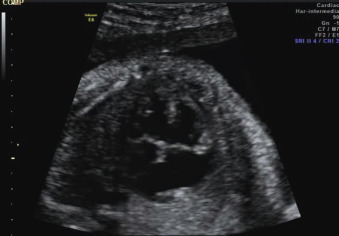
Fig. 86.1
Four-chamber view in complete TGA with significant perimembranous VSD.
- •
The five-chamber view or long-axis view is normal, with septopulmonary continuity. However, the vessel arising from the left ventricle, the pulmonary artery ( ) bifurcates into right and left pulmonary branches ( Fig. 86.2 ).
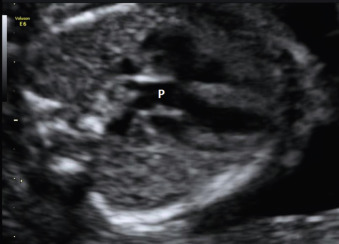
Fig. 86.2
Pulmonary artery (P) arising from left ventricle in complete TGA. There is early bifurcation of the left outflow tract into the right and left pulmonary branches.
- •
Crossover of the outflow tracts cannot be identified, because they run in parallel ( Fig. 86.3 ).
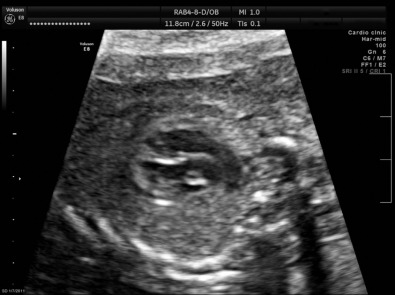
Fig. 86.3
Parallel disposition of great arteries. The aorta emerges anteriorly from the right ventricle, whereas the pulmonary artery originates from the posterior ventricle.
- •
The three-vessel and trachea view is usually abnormal with only two vessels ( Fig. 86.4 ), because the aorta emerges from the anterior–superior ventricle and has a hockey-stick shape, so that it runs in a superior plane with respect to the pulmonary arch.
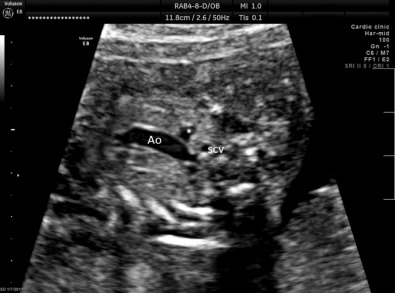
Fig. 86.4
Abnormal three-vessel and trachea view in which only the aorta (Ao), the superior cava vein (SCV), and the trachea can be identified (asterisk) .
- •
Longitudinal views identify the supraaortic vessels in the anterior aortic arch ( Fig. 86.5 ).
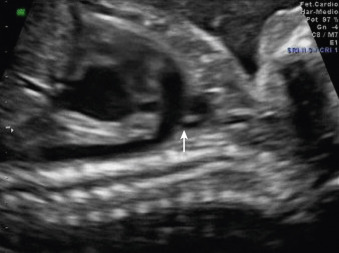
Fig. 86.5
Longitudinal view of the aortic arch emerging from the anterior ventricle. Note the hockey-stick shape and the supraaortic branching (arrow) far from the semilunar valve.
Other Applicable Modality
Four-Dimensional Echocardiography.
Simplified approaches have been proposed to improve the detection rate of complete TGA ( Fig. 86.6 ), but are not part of routine practice. In addition, four-dimensional (4D) echocardiography could be helpful in identifying associated abnormal coronary arteries patterns when evaluated in the en face view of the atrioventricular valves.
- •
Normal four-chamber view.
- •
Crossover of outflow tracts cannot be confirmed (see ).
- •
Aorta arising anterior and to the right from the right ventricle with a late branching, away from the semilunar valve (see Fig. 86.5 ).
- •
Pulmonary artery connecting the left ventricle with early bifurcation into the right and left pulmonary branches (see Figs. 86.2 and 86.6 ).
- •
Two vessels in three-vessel and trachea view (see Fig. 86.4 ).
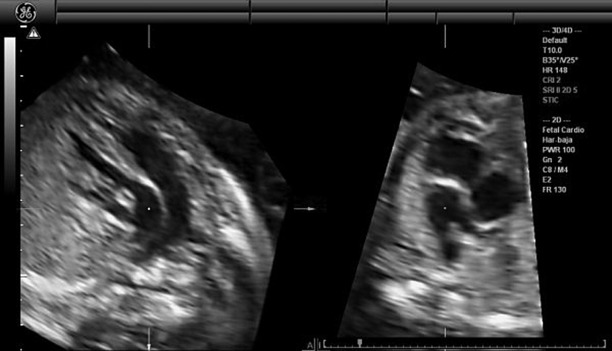
Differential Diagnosis From Imaging Findings
- 1.
Double-outlet right ventricle (DORV) can be difficult to distinguish from complete TGA with ventricular septal defects (VSDs). In DORV, the artery arising from the left ventricle overrides more than 50% of the septum.
- 2.
Differentiation from corrected TGA is critical (see later).
Stay updated, free articles. Join our Telegram channel

Full access? Get Clinical Tree







